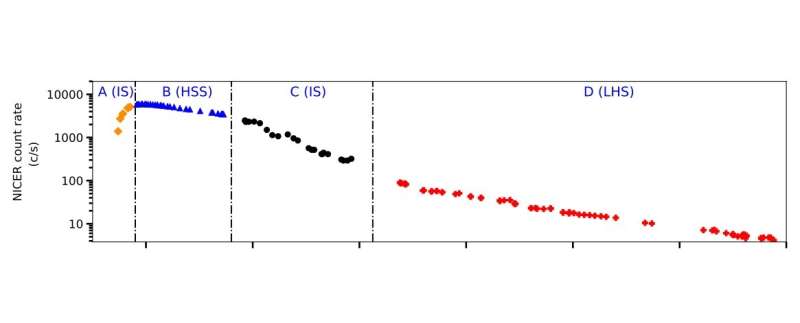NICER light curve of the 2018 outburst of MAXI J1727–203 in the 0.5 - 12 keV energy band. Credit: Jativa et al., 2020.
Using the NICER instrument, astronomers have conducted a detailed X-ray spectral and variability study of an outburst from an X-ray transient source known as MAXI J1727-203. Results of this investigation could shed more light on the true nature of this source. The study is detailed in a paper published July 22 on arXiv.org.
X-ray binaries consist of a normal star or a white dwarf transferring mass onto a compact a neutron star or a black hole. Based on the mass of the companion star, astronomers divide them into low-mass X-ray binaries (LMXB) and high-mass X-ray binaries (HMXB). LMXBs are known to contain a black hole (BH) or a neutron star (NS) and an evolved low-mass companion.
MAXI J1727-203 was detected in June 2018 by the Monitor of All-sky X-ray Image (MAXI) instrument aboard the International Space Station (ISS). The nature of MAXI J1727-203 is still debated, but it is assumed that the source is most likely a BH LMXB.
Shortly after its discovery, a team of astronomers led by Kevin Alabarta Jativa of the University of Southampton, U.K., started monitoring MAXI J1727-203 with the Neutron star Interior Composition Explorer (NICER) on ISS. The observations were carried out between June 5 and October 7, 2018, were focused on an outburst from this source.
"We present a detailed X-ray spectral and variability study of the full 2018 outburst of MAXI J1727–203 using NICER observations," the astronomers wrote in the paper.
The outburst lasted approximately four months, and during this time, MAXI J1727-203 exhibited three spectral states. By analyzing the transient's spectral and timing properties, the researchers found that it evolved through the soft, intermediate and hard spectral states.
According to the paper, spectral modeling in the 0.3–10 keV band revealed a soft thermal and a hard Comptonised component. The soft component was detected throughout almost the entire outburst. The contribution of the Comptonised component was less than 5% in the soft state, between 20 and 50% in the intermediate state, and over 80% in the hard state.
Furthermore, he power spectra of MAXI J1727–203 showed broadband noise up to the frequency of about 20 Hz, without any significant quasi-periodic oscillations (QPOs). The 0.01−64 Hz averaged fractional root-mean-square (rms) amplitude (0.5 − 12 keV) ranged from below 1.0 to 30%. In general, the fractional rms was found to increase with energy in most of the time during the outburst except the hard state.
The astronomers concluded that the results of the study provide further evidence that MAXI J1727-203 is a BH LMXB.
"Although we cannot unambiguously identify the nature of the compact object in MAXI J1727–203, the evolution in the HID [hardness-intensity diagram], RID [rms-intensity diagram] and HRD [hardness-rms diagram], and the temperature at the inner radius of the accretion disc during the softest observations, suggest that it is a BH," the researchers wrote.
More information: X-ray Spectral and Timing evolution of MAXI J1727-203 with NICER, arXiv:2007.11373 [astro-ph.HE]. arxiv.org/abs/2007.11373
© 2020 Science X Network
























